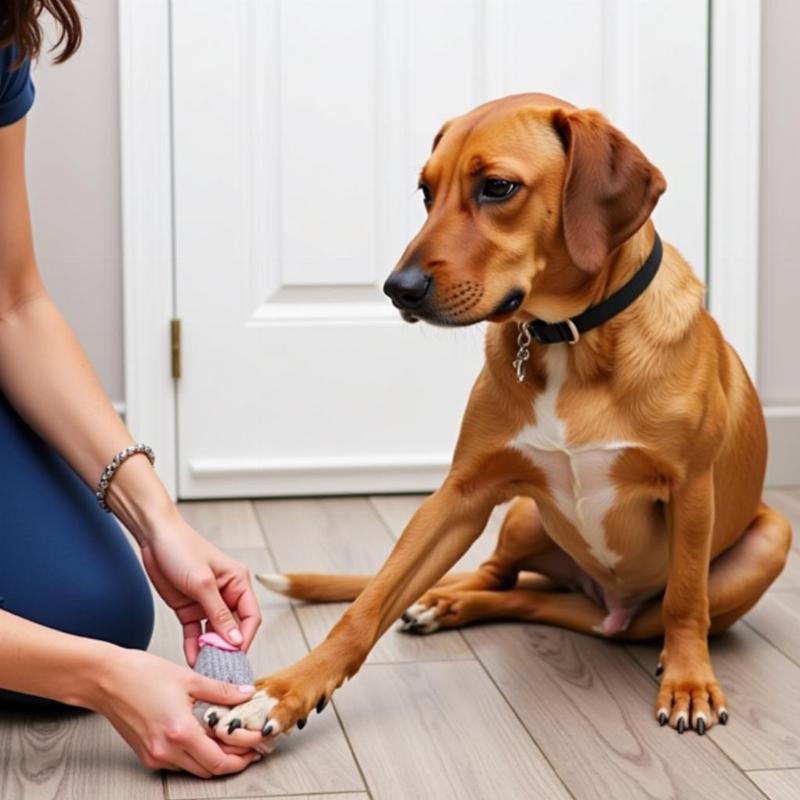Bee stings are a common summertime hazard for dogs. While most stings cause only mild discomfort, some dogs can have severe allergic reactions. Knowing what to do if your dog gets stung is crucial for their well-being. This article will guide you through the steps to take if your furry friend encounters a bee, from identifying the sting to providing appropriate care and knowing when to seek veterinary attention.
A bee sting can be a painful experience for your dog, causing localized swelling, redness, and itching. Understanding how to react quickly and effectively can minimize discomfort and prevent serious complications. From recognizing the signs of a sting to administering at-home care and understanding when professional help is needed, we’ll cover everything you need to know to ensure your dog’s safety.
Recognizing a Bee Sting in Your Dog
Identifying a bee sting can sometimes be tricky. Unlike humans, dogs often can’t tell us where they hurt. Common signs include:
- Whining or yelping: Your dog might vocalize in pain, especially immediately after the sting.
- Licking or pawing at a specific area: This is a classic sign of localized pain and irritation.
- Swelling: The area around the sting will likely swell, sometimes significantly.
- Redness: Look for a red, inflamed area.
- Visible stinger: If the bee was a honeybee, the stinger might still be embedded in your dog’s skin.
Removing the Stinger
If you see the stinger, removing it as quickly as possible is important. Unlike wasps, honeybees leave their stingers behind. Don’t use tweezers, as squeezing the stinger can release more venom. Instead, scrape it off with a flat object like a credit card or your fingernail.
Providing First Aid at Home
Once the stinger is removed (if present), you can administer basic first aid:
- Clean the area: Gently wash the sting site with mild soap and water.
- Apply a cold compress: This helps reduce swelling and pain. Wrap an ice pack in a towel and apply it to the area for 10-15 minutes at a time.
- Monitor for allergic reactions: While uncommon, severe allergic reactions can occur. Watch for signs like difficulty breathing, facial swelling, hives, vomiting, or collapse.
 Cách chữa trị chó bị ong đốt
Cách chữa trị chó bị ong đốt
When to Seek Veterinary Care
While most bee stings can be treated at home, some situations require professional veterinary attention:
- Multiple stings: If your dog has been stung multiple times, the cumulative effect of the venom can be dangerous.
- Stings inside the mouth or throat: Swelling in these areas can obstruct breathing.
- Allergic reaction: Any signs of an allergic reaction warrant immediate veterinary care.
- Excessive swelling or pain: If the swelling is severe or your dog appears to be in significant pain, it’s best to consult a veterinarian.
Preventing Bee Stings
Taking preventative measures can help minimize your dog’s risk of getting stung:
- Keep your dog away from known bee hives or nests.
- Avoid using sugary drinks or foods outdoors, which can attract bees.
- Supervise your dog closely when they are outside, especially during warmer months.
Conclusion
Knowing what to do when a dog gets a bee sting is crucial for every responsible pet owner. By recognizing the signs, acting quickly, and seeking professional help when necessary, you can ensure your furry friend’s safety and well-being. Remember to keep a close eye on your dog during outdoor activities, especially in areas where bees are likely to be present.
FAQs
- Can I give my dog Benadryl for a bee sting? While Benadryl can sometimes be used for mild allergic reactions in dogs, it’s crucial to consult with your veterinarian before administering any medication.
- How long does it take for a bee sting to heal in a dog? Most bee stings heal within a few days, but it’s important to monitor the area for any signs of infection.
- Are some dogs more allergic to bee stings than others? Yes, just like humans, some dogs are more susceptible to allergic reactions from bee stings than others.
- What are the signs of a severe allergic reaction in a dog? Difficulty breathing, facial swelling, hives, vomiting, and collapse are all signs of a severe allergic reaction.
- Can a bee sting be fatal to a dog? In rare cases, a severe allergic reaction can be life-threatening.
- What should I do if my dog eats a bee? If your dog eats a bee, monitor them closely for any signs of swelling or difficulty breathing. Contact your veterinarian immediately if you notice any concerning symptoms.
- Are there any home remedies for bee stings in dogs? While some home remedies like baking soda paste are suggested, it’s always best to consult with your veterinarian before trying any home remedies.
Related Articles
Beautdogs.us is your premier online resource for all things dog-related in the United States. We provide expert advice on dog breeds, grooming, training, health, and nutrition. Whether you’re a seasoned dog owner or just starting your journey with a furry companion, Beautdogs.us is your trusted source for comprehensive and engaging information to ensure the well-being of your beloved canine. Contact us today for all your dog-related inquiries at [email protected] or +1 501-555-7529. Visit Beautdogs.us for more expert guidance and valuable resources.